What Is Private Line Emulation?
Available Languages
Bias-Free Language
The documentation set for this product strives to use bias-free language. For the purposes of this documentation set, bias-free is defined as language that does not imply discrimination based on age, disability, gender, racial identity, ethnic identity, sexual orientation, socioeconomic status, and intersectionality. Exceptions may be present in the documentation due to language that is hardcoded in the user interfaces of the product software, language used based on RFP documentation, or language that is used by a referenced third-party product. Learn more about how Cisco is using Inclusive Language.
Communication Service Provider (CSP) networks have been built to deliver distinct services with unique requirements using specific technologies. The resulting networks are operationally complex arising from the diversity in networking software implementations, multiple protocols, siloed management of layers, and manual processes. This complexity has constrained the ability to deliver seamless experiences to customers independent of their location, or the network to which they are connected.
Today’s networks have become hierarchical multilayered networks where each layer has a function, a role, and a lifecycle. Traditionally, operators would spend time and money upgrading their IP layer with new capacity, monitoring tools, and hardware. Shortly thereafter, the optical team would perform similar upgrades to the Optical Transport Network (OTN) to support the new capacity requirements coming from the IP layer. These disjointed lifecycle management processes create duplicate, persistent, and recurring costs, downtime, and a system potentially exposed to configuration or management errors.
The optical layer was built to transparently carry guaranteed high-capacity bandwidth. At that time, routers did not have appropriate mechanisms to deliver bandwidth guarantees and handle the failures that the optical layer could. In addition, router ports had lower bit rates and were more expensive to deploy. Routers now have fast convergence and restoration features, and port capacity is almost equal to the optical client port speeds. Cisco has also developed innovative technologies and solutions to optimize IP. With new silicon (Cisco Silicon One™) that will go up to 25.6 Tbps in a single NPU (see Chart 1 below on how NPU bandwidth has outpaced traditional transport options), new coherent pluggable optics supporting 1.2 Tbps per wavelength, advances in Raman and the L-band, and Cisco Crosswork® Automation, a new architectural paradigm has come to market—The Routed Optical Network. This shift enables exactly what CSPs need today— scalability, simplicity, restoration, reliability, and performance, while reducing the overall operational cost structure.
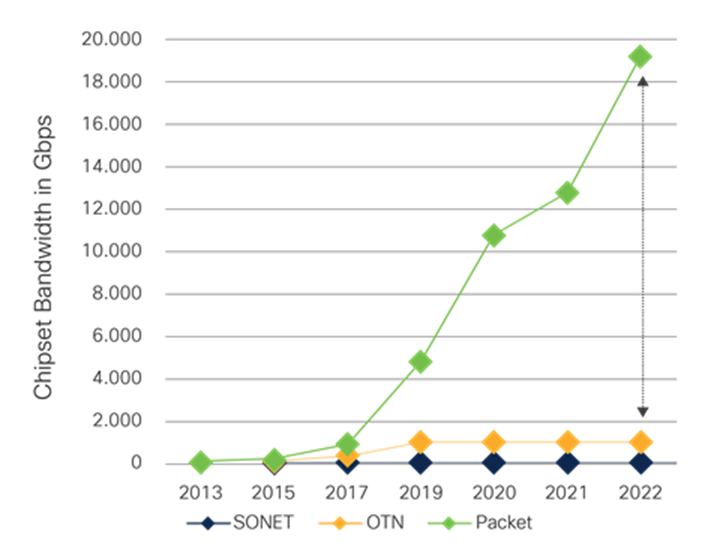
Growth of chipset bandwidth in Gbps
By optimizing the optical and IP layers, Cisco has now extended the innovation to move bit-transparent services to the IP layer. Services need to get from ingress to egress, meet SLAs, and be as cost efficient as possible while reducing their carbon footprint. In addition, they now account for the major bandwidth growth. By focusing on the service layer, we can use Private Line Emulation (PLE) plus 400G ZR/ZR+ optics and automation enhancements to converge layers and simplify the network, enhancing the lifecycle management of the network.
What is Private Line Emulation?
PLE enables private line services to be carried over the same IP network for non-Ethernet type services like SONET/SDH and Fibre Channel. Using PLE maintains the same service-level agreements and service characteristics such as guaranteed bandwidth and persistent bidirectional paths using the innovation in Circuit-Style Segment Routing (CS-SR). It includes Ethernet Virtual Private Network (EVPN) extensions for setup and control and circuit emulation for bit transparency.
PLE is fully automated via Crosswork Network Automation, which supplies bandwidth reservation, bidirectional path optimization, service assurance, and orchestration for private line services, and service visibility from the service layer down to the fiber. Crosswork additionally supplies visibility through consolidated views on state and operations to verify and monitor customer experience as well as insights by gathering operational intelligence through correlated data to identify patterns on network services health and trends.
Converging private line services onto the packet layer may raise concern about service latency. The concern arises from running critical optical services over a packet network, which traditionally meant introducing latency and reduced reliability. However, packet networks are no longer slow, nor do they have high latency, thanks to the hardware-based packet forwarding engines (NPUs mentioned above). Latency can be introduced by congestion (where buffering would still need to be used), but by using strict bandwidth accounting (traffic engineering) and Quality of Service (QoS) mapping to strict priorities, one can ensure overall transfer delay of a packet node to be under 10 μsec, which is lower than most OTN switches.
Wavelength services or private line services are typically point to point and fully transparent and usually are delivered using Dense Wavelength Division Multiplexing (DWDM) and OTN technology. The dedicated resource allocation (time slot or wavelength) and support for multiple protocols differentiates private line services from classical switched Ethernet or MPLS E-line services. Advances in packet switching silicon compared to OTN and SONET/SDH chipset advances make packet switching/routing the most efficient means of transport with the lowest cost/bit.
Industry-standard PLE is supported on the Cisco® NCS 57C3 and NCS 55A2 router platforms. The platforms support the 8x10G SFP+ PLE MPA (NC55-OIP-02) with the following interface types: STM-16/OC48, STM- 64/OC192, 1GE, 10GE, OTU2/2e, and FC-1/2/4/8/16/32G. Cisco IOS® XR software supports CS-SR for guaranteed bandwidth and bidirectional paths. It also provides end-to-end path protection and restoration and EVPN extensions for PLE service setup.
A recent segment routing innovation (see Figure 1) known as CS-SR is providing a connection-oriented underlay transport. A combination of CS-SR and EVPN-VPWS allows CSPs to deliver E-line services with dedicated resource allocation, sometimes referred to as dedicated E-line services, when bit transparency or non-Ethernet interface support is not required and strict bandwidth guarantees are preferred over the simplicity and scalability of ECMP-based segment routing.
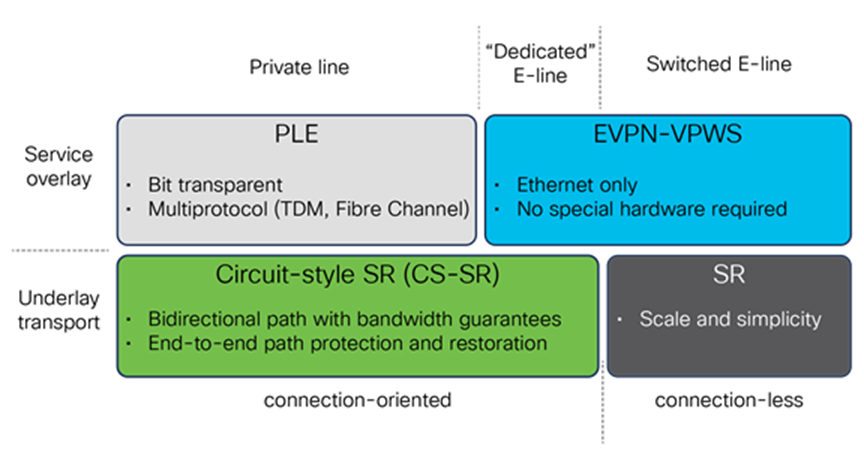
Innovations in service delivery
How Private Line Emulation Works
Rather than working at the Ethernet frame level, PLE operates at the bit-stream level. Bits received on an ingress port are encapsulated in Virtual Private Wire Service (VPWS) packets and sent across to the far-end router. As with other emulation technologies, the far-end router stores packets in a de-jitter buffer and implements Differential Clock Recovery (DCR) using Real-time Transport Protocol (RTP) timestamps being added to the VPWS packets as they are being sent by the ingress node. The recovered clock is used to play out the bit stream using the payload of the VPWS packets (Figure 2). The structurally agnostic nature of PLE allows it to carry not only Ethernet, but also protocols such as Fibre Channel, SONET/SDH, and OTN at various speeds from 1 Gbps up to 400 Gbps.
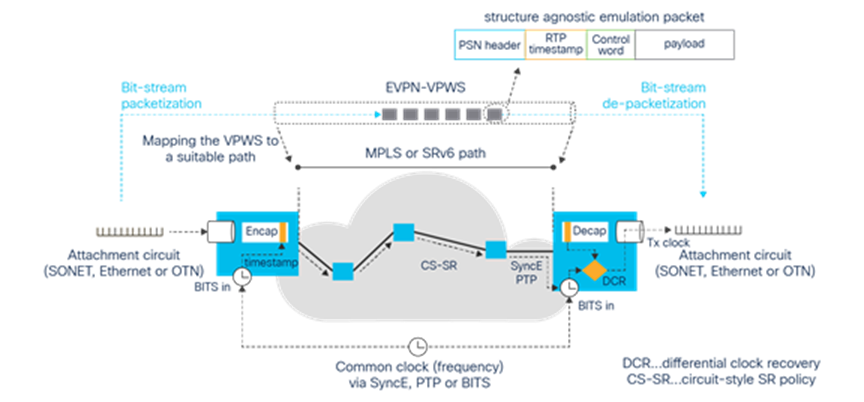
PLE operates at the bit-stream level
Circuit-Style Segment Routing (CS-SR)
In an IP/MPLS network, traffic engineering is typically used for network optimization and to deal with congestion. Operational and scale challenges with MPLS-TE(RSVP) can quickly arise with full and partial mesh topologies. CS-SR supplies traffic engineering capabilities without the need for state being managed by routers. Path computation and bandwidth bookkeeping (Figure 3) are done by a centralized Path Computation Element (PCE).
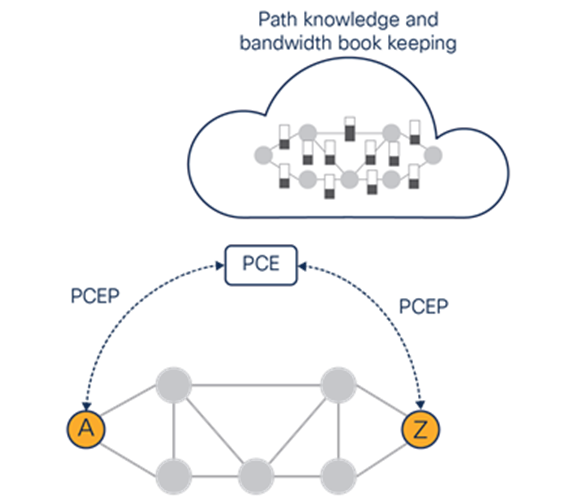
PCE for path computation and bandwidth tracking
The stateless nature of CS-SR allows for application of it on a per-service manner, which allows for each service/service type to have dedicated bandwidth given. Furthermore, bidirectional and co-routed path computation and end-to-end path protection provided by CS-SR does satisfy the key path routing and resiliency requirements of transport network operators as seen in Figure 4.
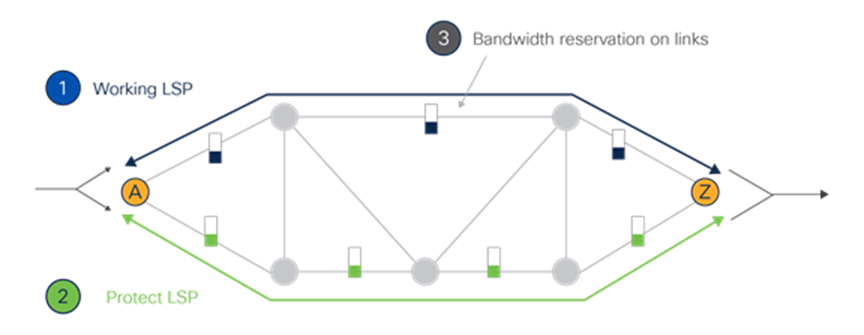
CS-SR and bandwidth reservation
Local protection paradigms such as MPLS-TE Fast Re-Route (FRR) and Segment Routing Topology-Independent Loop-Free Alternate (TI-LFA) lack the extra layer of ability to divert traffic onto an alternate path while supplying guaranteed bandwidth allocation on the new path. To do this requires an added “what if” network planning step to ensure no network congestion is introduced for any possible failure scenario. CS-SR can solve this scenario without the need for the added network planning step (Figure 5).
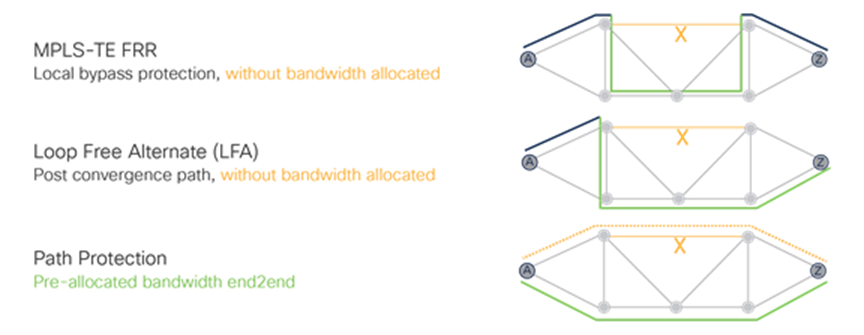
Path protection
The end-to-end path protection scheme only sends traffic across pre-established, working, or protected paths through the network—with bandwidth being allocated at provisioning time for both the primary and failover paths. There is no need for added “what if” analysis using an offline tool.
By encoding the path using a list of strict adjacency Segment IDs (SIDs), traffic is only sent across the desired path (list of links) in a deterministic and persistent manner. If any of the links along the path goes down, the CS-SR path will go down and remain down as well. Of course, if end-to-end path protection is enabled, then the traffic will be switched to the protect path (Figure 6).
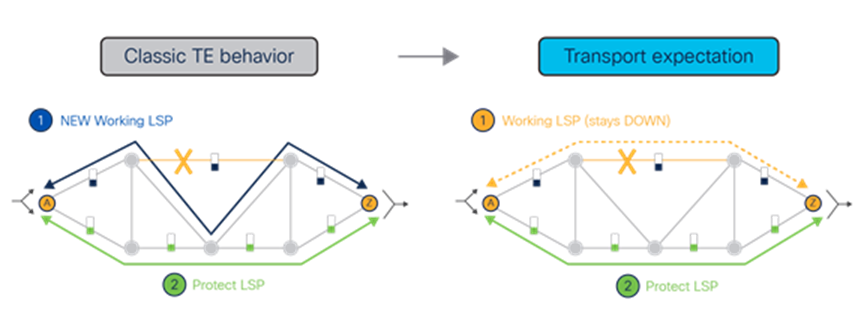
Protect LSP behavior
This failover design does introduce a further requirement to deal with a catastrophic network failure event. When both the working and protect path go down and stay down, the network operator needs a tertiary, best-effort but bandwidth-guaranteed, alternate path. This restoration solution (Figure 7) can be used either in conjunction with both a working and protect path (1:1+R) or just a working path (1+R).

Restoration solution
Private Line Emulation enables private line services to be carried over the same IP/MPLS network for non-Ethernet type services like SONET/SDH and Fiber Channel. PLE includes EVPN extensions and circuit emulation for bit transparency and keeps the same service-level agreements and service characteristics such as guaranteed bandwidth and persistent bidirectional paths using the innovation in CS-SR.
With PLE and CS-SR available, network operators can focus on building out a single segment-routed network to support the full breath of services without the need for deploying dedicated optical transport equipment such as OTN switches and muxponders. This improves resource utilization and reduces CapEx, and the simplified network architecture reduces OpEx, improves service agility, and meets the challenges of reducing overall carbon emission.
Learn more about Routed Optical Networking.